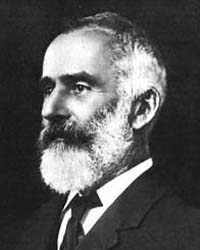
|
 Lawrence Hargrave 1850-1915
Lawrence Hargrave 1850-1915On November 12, 1894, Lawrence Hargrave, the Australian inventor of the box kite, linked four of his kites together, added a sling seat, and flew 16 feet. By demonstrating to a sceptical public that it was possible to build a safe and stable flying machine, Hargrave opened the door to other inventors and pioneers. The Hargrave-designed box kite, with its improved lift-to-drag ratio, was to provide the theoretical wing model that allowed the development of the first generation of European (and American) airplanes. In the 1890s a small number of inventive technologists were working to translate infant aviation theory into airplanes. Leading the race was Hargrave, a quintessential nineteenth-century gentleman scientist of independent means. A gifted explorer, astronomer, amateur historian, and practical inventor, Hargrave devoted most of his life to constructing a machine that would fly. He believed passionately in open communication within the scientific community and would not patent his inventions. Instead, he scrupulously published the results of his experiments.
The direct line of Hargrave's influence on the evolution of flying is more discernible in Europe. The French (who thought that France was the cradle of aviation) freely acknowledged Hargrave's influence: Alberto Santos-Dumont was the first European to fly a heavier-than-air machine constructed of Hargrave box kites in 1906. When Gabriel Voisin built the first commercially available aircraft, based on the stable lifting surfaces of Hargrave's box kites, he called them "Hargraves." In 1889 Hargrave revolutionised engine technology by inventing the radial rotary engine, which reappeared (unacknowledged) in modified form in 1908 as the French Gnome engine. Although as early as 1892 Hargrave had voiced his opposition to the idea of the "connection of the flying machine with dynamite missiles," the rotating radial engine was extensively used in military aircraft until it was superseded by new engine technologies many years later. Hargrave's concern for the peaceful promulgation of knowledge was evidenced in his concern for the safe placement of his working models in an environment open to the public. The only museum that would meet his terms was the Deutsches Technological Museum in Munich. It is ironic that most of Hargrave's 176 working models were destroyed in the Allied aerial bombardment of Germany during World War II. The 25 surviving models were restored in the 1960s to Sydney, Australia's Powerhouse Museum, which is staging an exhibition to mark the centennial of Hargrave's first flight. Octave Chanute wrote in 1893 that "If there be one man more than another who deserves to succeed in flying, that man is Mister Lawrence Hargrave of Sydney." But Hargrave never did solve the power-to-weight ratio problem. His 1902 design was put to the test in 1992 when students at the University of Sydney rebuilt his aircraft from the original blueprint, replacing Hargrave's power plant with a modern one. ...It flew.
Lawrence Hargrave 1850-1915 Australian aviation pioneer, inventor, explorer, mason and astronomer. He was born in Greenwich England on January 29, 1850 and educated in England at Queen Elizabeth's Grammar School, Kirkby Lonsdale, Westmoreland. In 1872 he came to Australia in search of gold, but the ship chartered by the group of adventurers was wrecked off the Queensland coast. In the 1870's after exploring in the hinterland behind Port Moresby, in June 1877 he decided to settle down and elected a member of the Royal Society of New South Wales. In 1878 he was appointed an assistant astronomical observer at Sydney Observatory, a post which he held until 1883, when he retired to devote the remainder of his life to research work into problems connected with human flight. In 1884 and 1892 he experimented with monoplane models, and in 1889 he constructed a rotary airplane engine, driven by compressed air. In 1892 Hargrave discovered that a curved wing surface appeared to give a greater lift than a flat supporting surface. Then he turned his attention to research into the behavior of various types of kites. During the course of his experiments he found out that a curved surface had twice the lift as a flat one, and next he discovered that a kite with two separated "cells" or double planes, had the greatest stability and oaring power. While the Wright brothers denied that they owed anything to Hargrave, his discovery of the cellular kite and his investigations into the superiority of curved wing surfaces played an important part in European experimental work which culminated in the first public flight by Santos-Dumont in France in 1906. His son and fellow experimenter, Geoffrey Lewis Hargrave, was killed at Gallipoli in May 1915, and this terrible news caused him to become seriously ill, and he died in a hospital on July 6, 1915 |
© Copyright 1999 CTIE - All Rights Reserved - Caution |